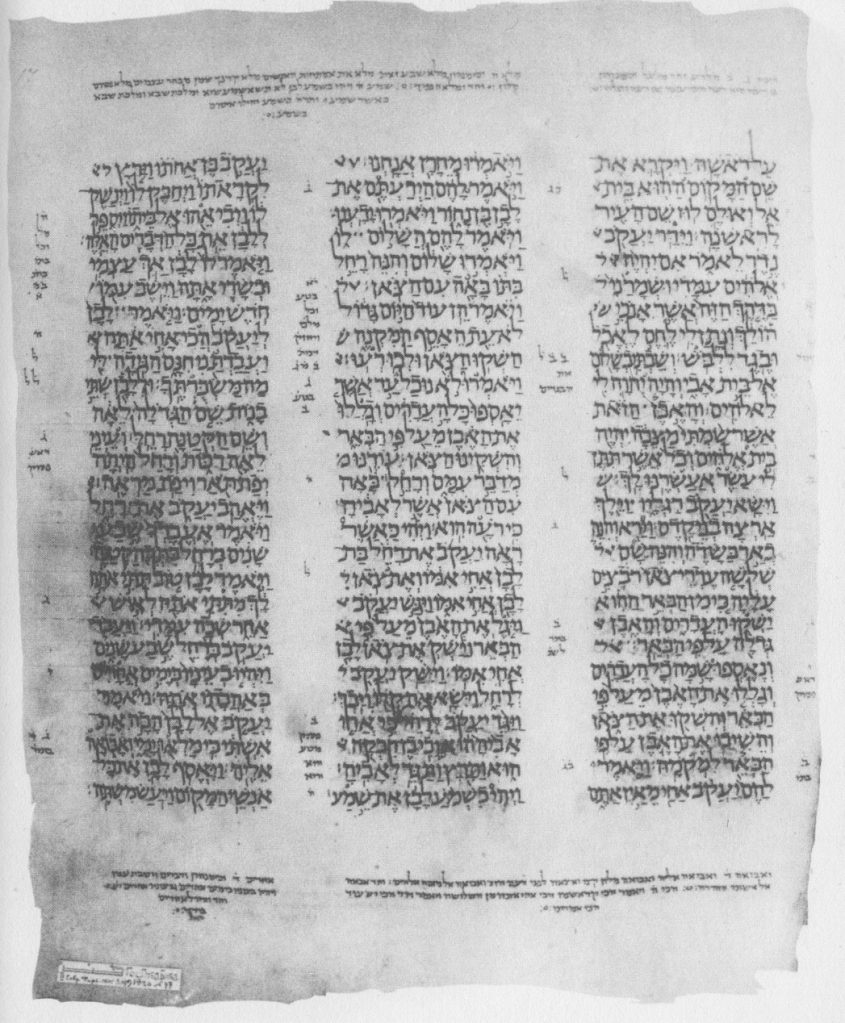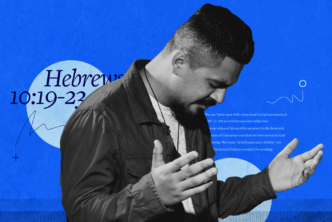Since I began actively working with the Dead Sea Scrolls over a decade ago, I have become increasingly convinced that they are fundamental to understanding the Bible. In this post I would like to explore two of the more significant ways that the Dead Sea Scrolls can contribute to studying the Bible and make suggestions for how readers can begin to make use of them more effectively.
Textual Criticism of the Hebrew Bible/Old Testament
The Hebrew Bibles most commonly used in scholarly circles and personal Bible study merely reproduce the text of a single 11th century manuscript in St. Petersburg with occasional footnotes that say where other manuscripts and ancient translations disagree with it.
But these critical editions only rarely incorporate the important evidence from the Dead Sea Scrolls, which often provide manuscript evidence for passages of the Bible that are over 1,000 years older than the base text used in these editions.
Over 200 copies of biblical books were discovered in different locations in the Judean Desert, and these provide some of the most important evidence for the earliest developments in the history of the biblical text and the interpretation of these books around the time of Jesus.
Thankfully, Stephen Pfann has prepared the Qumran Biblical Dead Sea Scrolls Database to give easy access to all of these scrolls for users of Logos.
By setting this database as one of your preferred Bibles, any time you search for a passage in the Hebrew Bible/Old Testament, you will easily be able to see if any Dead Sea Scrolls have your passage, what exactly they say, and whether they agree or disagree with later manuscripts.
For those who do not know Hebrew, Logos offers a similar English-language resource in the Dead Sea Scrolls Bible by Martin Abegg, Peter Flint, and Eugene Ulrich, where you can see translations of all of the biblical scrolls.
With these resources at your fingertips, you will have full access to the earliest textual evidence and be able to see for yourself what the Dead Sea Scrolls contribute to our understanding of the Hebrew text.
Context for Second Temple Judaism and the New Testament
Recent decades have seen a major change in how New Testament scholars are typically trained, largely in response to the discovery of the Dead Sea Scrolls. In earlier generations, many scholars focused on classical Greek language and literature and the Greek cultural background of the New Testament.
But now it has become increasingly common for scholars to be trained primarily in Second Temple Judaism, which provides crucial context for understanding the writings of the Jewish authors of the New Testament. The Dead Sea Scrolls are essential reading for understanding the Jewish background of the New Testament. They give direct, authentic insight into the ways ancient Jewish authors interpreted scripture, engaged in theological discussions, and debated ritual practices.
They are also first-hand evidence for the socio-religious dynamics within and between groups in that period, as well as developments in languages and technical vocabulary. For instance, one composition found at Qumran (4QMMT) famously discusses the “works of the law,” which has had a significant impact on how scholars understand Paul’s parallel use of the phrase.
With the Qumran Sectarian Manuscripts database by Martin Abegg, you will have instant access to the full corpus of non-biblical Dead Sea Scrolls, complete with full information on the form of each word to make it easier to translate and to enhance search functionality.
With this added information, you can easily do grammatical and vocabulary searches on the largest corpus of Hebrew-language literature outside of the Bible and before the Mishnah. You can also search for biblical citations and allusions among the Dead Sea Scrolls to see how biblical texts were referenced and interpreted.
This resource can also be paired with the Dead Sea Scrolls Study Edition by Florentino García Martínez and Eibert Tigchelaar, which gives alternative Hebrew/Aramaic transcriptions and English translations for the most important scrolls.
For those who prefer to read the scrolls in English, Logos also offers The Dead Sea Scrolls in English by Geza Vermes and The Dead Sea Scrolls: A New Translation by Michael Wise, Martin Abegg, and Edward Cook. There is also the recently released Lexham DSS Hebrew English Interlinear Bible.
With these resources you will be able to read these important documents to familiarize yourself with the context of ancient Judaism and the New Testament and to check citations of Dead Sea Scrolls you find in commentaries and other literature in their original contexts.
Example: Exodus 1:1-5
A good example of the value of the Dead Sea Scrolls for understanding both the Bible and ancient interpretation can be seen by working through two sets of textual differences in Exodus 1:1-5.
If you have chosen to prioritize your Biblical Dead Sea Scrolls database, you can search this passage from the homepage, but if not you can find which manuscripts have parts of these verses (4QGen-Exoda, 4QpaleoGen-Exodl, and 4QExodb) by looking at the Bible Reference Index that comes with the resource. You can then systematically check each of these manuscripts against your normal Hebrew Bible.
If you are using English resources, bring up the Dead Sea Scrolls Bible alongside your favorite English Bibles. When you compare these Dead Sea Scrolls with your usual biblical texts, you will find some important differences.
Joseph’s role in the story
The first interconnected set of textual differences has to do with the role of Joseph, which I have colored in red in the above screenshot. While Joseph is lacking in the list of names in verses 1-3 in every other manuscript, he is found inserted into the list after Zebulon in 4QExodb (red rectangle; unfortunately the Dead Sea Scrolls Bible does not note this variant).
Furthermore, 4QGen-Exoda and 4QpaleoGen-Exodl both agree with our medieval Hebrew texts (Masoretic text = MT and Samaritan Pentateuch = SP) in putting the phrase “And Joseph was in Egypt” at the end of verse 5 (red underline). But, once again, 4QExodb disagrees, lacking that phrase at the end of verse 5 (red X).
Those using the English Dead Sea Scrolls Bible will find this noted in footnote 6, where it also points out that the Old Greek translation (Septuagint = LXX) does not have this phrase at this location.
Advanced original-language users, or those who have access to one of the English translations of the Septuagint (Brenton’s Septuagint: English Translation or The Lexham English Septuagint) can check and see that the Greek translation put the phrase “And Joseph was in Egypt” at the beginning of verse 5, rather than the end.
The fact that this phrase is completely lacking in one ancient manuscript and occurs in two different locations in the rest of the manuscript tradition suggests to me that it was not originally in the text of Exodus. At some point it was added into the margin of a manuscript to clarify the ambiguity of why Joseph was not included in the list and was subsequently inserted into the main text of many manuscripts in different locations.
4QExodb, on the other hand, escaped this insertion, and at some point a scribe added Joseph to the list of brothers where he expected to find him, not realizing why Joseph’s name had been left out in the first place. Thus, it appears to me that the earliest version of Exodus was entirely silent about Joseph, assuming that readers knew he was in Egypt, whereas later manuscripts attempted to clarify his role.
The Dead Sea Scrolls, at least in Exodus 1, therefore, give a window into an earlier form of the text than is reflected in our standard Hebrew and English Bibles, which already reflect a layer of interpretation.
How many descendants?
The second major textual problem is the number of descendants that Jacob brought with him to Egypt in verse 5. All medieval Hebrew Bibles (and hence most English Bibles) say that Joseph had 70 descendants, based on one version of Genesis 46:6-27.
But there is also an alternative version of this passage where the list of descendants is supplemented with additional names taken from Numbers 26:28-37 and the number of descendants adds up to 75. This number is found in the Septuagint of Exodus and in Stephen’s speech in Acts 7:14.
Interestingly, both Dead Sea Scrolls that are preserved at this point (4QGen-Exoda and 4QExodb) also say 75 in agreement with the Septuagint and New Testament (green underline), but they add the extra 5 in different positions (in Hebrew, both “seventy and five” and “five and seventy” are syntactically acceptable).
In my opinion, this shows that 75 is not the original reading of Exodus, but rather that multiple scribes at different points in time changed the number from 70 to 75 to make it fit with their revised reckoning on the basis of Genesis 46, which must have been a widely known interpretive tradition.
Thus, while the Dead Sea Scrolls in this case do not give us an earlier text than our medieval Hebrew Bibles and modern English translations, they do give us great insight into how the text was being interpreted and revised in the times before Christ.

The resources on the DSS available on Logos are numerous, from DSS bibles to highly specialized monographs, as well as a host of exceptional tools for searching, analyzing, and viewing the scrolls and other biblical and non-biblical literature.








